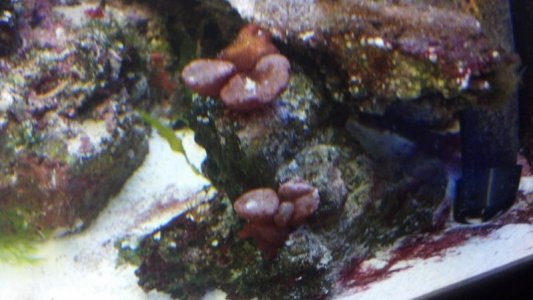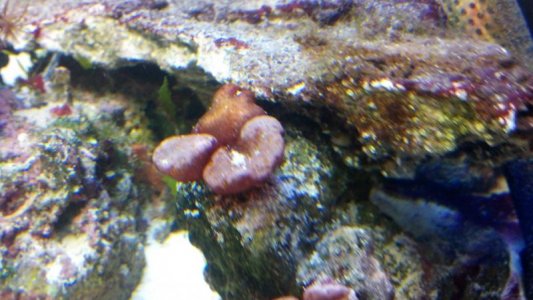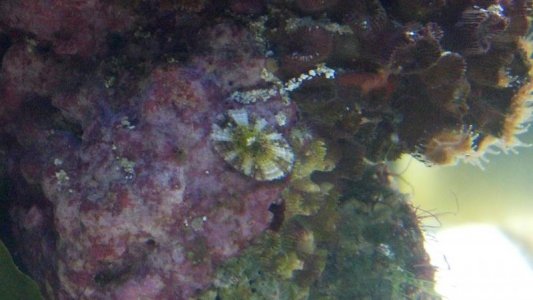You are using an out of date browser. It may not display this or other websites correctly.
You should upgrade or use an alternative browser.
You should upgrade or use an alternative browser.
Pix & ID: Critters that come in your rocks: the good and the bad.
- Thread starter Sk8r
- Start date
SushiGirl
Premium Member
Looks lke algae & the feathery tips make me think bryopsis. There's an algae thread on here that talks about killing algae with hydrogen peroxide. You could try a hydrogen peroxide dip. Tank water & hydrogen peroxide mixed. I don't remember how much. Run a search on the zoanthid forum for "hydrogen peroxide dip."
SushiGirl
Premium Member
Algae is normal in new tanks & nothing to do something as drastic as "cooking" the rock (which isn't really boiling or baking in the oven for those who don't know), even though lots of people like to respond in threads here in ways that make it seem the end of the world LOL. Continued good maintenance will help get & keep your parameters where they should be to not support nuisance algae.
Looks like your tank is small & new. I would take each rock out & place a small drop of hydrogen peroxide on each piece of algae you see, including the small sections of hair algae, then just put the rocks back in your tank. From what I've read, it won't appear to do anything at first but it will kill it. That caulerpa I see in both pics you should pull out along with any runners you can manage to pick off. If you can't get all the runners, drop some hydrogen peroxide on them too.
I think I see a small aiptasia in there too. Hit it with lemon juice injected in the mouth.
Looks like your tank is small & new. I would take each rock out & place a small drop of hydrogen peroxide on each piece of algae you see, including the small sections of hair algae, then just put the rocks back in your tank. From what I've read, it won't appear to do anything at first but it will kill it. That caulerpa I see in both pics you should pull out along with any runners you can manage to pick off. If you can't get all the runners, drop some hydrogen peroxide on them too.
I think I see a small aiptasia in there too. Hit it with lemon juice injected in the mouth.
Cymonous
My Clown Attacks Me
Algae is normal in new tanks & nothing to do something as drastic as "cooking" the rock (which isn't really boiling or baking in the oven for those who don't know), even though lots of people like to respond in threads here in ways that make it seem the end of the world LOL. Continued good maintenance will help get & keep your parameters where they should be to not support nuisance algae.
Looks like your tank is small & new. I would take each rock out & place a small drop of hydrogen peroxide on each piece of algae you see, including the small sections of hair algae, then just put the rocks back in your tank. From what I've read, it won't appear to do anything at first but it will kill it. That caulerpa I see in both pics you should pull out along with any runners you can manage to pick off. If you can't get all the runners, drop some hydrogen peroxide on them too.
I think I see a small aiptasia in there too. Hit it with lemon juice injected in the mouth.
Thank you very much SushiGirl. Where do you see the Aiptasia? I do have a lot of tube worms on my rocks though too, but those are mainly on my other rock. I did pull off those large pieces of bubble algae at the base and even scraped off a bit more off the rock. I also found a few small pieces around the rock that I managed to get off as well. And yes, my tank is small and new.
I have just noticed I have a lot of these really fine, translucent white worms. They are as thin as a hair, and some come out of tubes while some are moving around freely. It's just a single thread-like thing, not a whole bunch of tentacles together. What could they be, and are they good or bad? Thanks!
KCombs
They Call me "RifRaf"
I found a couple of these moving around on my rock. Is this some kind of snail?
Thats a limpet & "usually" benign
KCombs
They Call me "RifRaf"
I am really new to this hobby. I have done freshwater planted for a while now, but have no experience with salt water. Started reading a couple of days ago. All these hitchhikers makes me wonder if I am taking the right decision
its the hitchhikers and the changes that make reef tanks interesting....
whereas a tank full of amazon swords & balloon mollies is comparativley less so
SushiGirl
Premium Member
Dave, I don't keep planted aquariums, though I'd love to. I tried keeping grape caulerpa in my old 38 sumpless tank, but lost the entire tank to it going sexual one weekend when I was out of town. I do have a really full fuge right now, though, with tons of dragon's breath, some feather caulerpa that we pull out every couple of weeks, way too large a ball of chaeto, and some pieces of a macro that showed up in the main tank after a year of that live rock being put in.
Cymonous, aiptasia is in the upper left corner of the 2nd pic.
Salty, not sure what your worms are & I'm restricted to my bed & the phone right now, which makes searching harder. Are the non-tube ones on the rock or glass? I know what the tube ones are, but can't think what the name is at the moment, but the ones I'm thinking of are harmless. Some call them fisherman worms.
Cymonous, aiptasia is in the upper left corner of the 2nd pic.
Salty, not sure what your worms are & I'm restricted to my bed & the phone right now, which makes searching harder. Are the non-tube ones on the rock or glass? I know what the tube ones are, but can't think what the name is at the moment, but the ones I'm thinking of are harmless. Some call them fisherman worms.
SushiGirl
Premium Member
I missed this page LOL.
Ac0go, great to hear!
Dave, the hitchhikers are what got me hooked on this hobby, the majority of them are harmless, the majority of the ones that aren't are treatable. Besides the 6 1/2 year break I took, having 4 tanks (5 now, just set one up a week ago) over a period of several years, I've never had a hitchhiker be something so bad that I had to break a tank down because of it. Lots of people blow natural occurences way out of proportion & decide drastic action is necessary when it's not. I've had minor nuisance algae of various kinds, several types of hydroids, aiptasia, 2 kinds of "bad" flatworms, bristleworms by the hundreds, asterina stars by the hundreds, very high nitrates & phosphates, and a eunicid worm I intentionally added a long time ago that was sold to me as something else, and never put a chemical in my tank or broke it down because of it. Really the biggest thing to fear in this hobby is cost LOL.
Ac0go, great to hear!
Dave, the hitchhikers are what got me hooked on this hobby, the majority of them are harmless, the majority of the ones that aren't are treatable. Besides the 6 1/2 year break I took, having 4 tanks (5 now, just set one up a week ago) over a period of several years, I've never had a hitchhiker be something so bad that I had to break a tank down because of it. Lots of people blow natural occurences way out of proportion & decide drastic action is necessary when it's not. I've had minor nuisance algae of various kinds, several types of hydroids, aiptasia, 2 kinds of "bad" flatworms, bristleworms by the hundreds, asterina stars by the hundreds, very high nitrates & phosphates, and a eunicid worm I intentionally added a long time ago that was sold to me as something else, and never put a chemical in my tank or broke it down because of it. Really the biggest thing to fear in this hobby is cost LOL.
I know a lady who lives in Fort Worth, TX, who is extremely knowledgeable in planted fresh water, I thought you might be the same person.  After reading all 39 pages of this thread since last night, your knowledge of hitch hikers still astounds me considering they all look the same to me. Now I have more questions than before I started reading the first post.
After reading all 39 pages of this thread since last night, your knowledge of hitch hikers still astounds me considering they all look the same to me. Now I have more questions than before I started reading the first post. 
A lot of posts here pertain to Atlantic rock and the freebies that comes with it. Does that mean chances of getting harmful hitchhikers are less if I buy Pacific rock ? I can probably guess the answer, but I would like to know from an expert like you before I spend my hard earned money and not get any added benefit.
A lot of posts here pertain to Atlantic rock and the freebies that comes with it. Does that mean chances of getting harmful hitchhikers are less if I buy Pacific rock ? I can probably guess the answer, but I would like to know from an expert like you before I spend my hard earned money and not get any added benefit.
SushiGirl
Premium Member
I'm assuming by Atlantic live rock you mean the dry rock that is mined in Florda then placed in the ocean for stuff to grow on it (maricultured rock). To me there's an equal risk of good & bad hitchers on it. I don't know of any Pacific maricultured rock available. As far as I'm aware, due to CITES restrictions, rock from those areas are to be cured & any obvious life such as corals, sponges, clams, etc nust be killed or removed before shipment to the US. All the rock I've bought is from Vanuatu & comes only as pre-cured & cured from the place we bought it from. Pre-cured is stripped of obvious critters & kept on shelves where it's sprayed down with seawater several times a day for at least 2 weeks & still has beautiful coralline colors & I've still gotten hydroids that are hidden, a small white chiton that was hidden, and now a macroalgae that showed up over a year later. The tank we just set up, my boyfriend bought cured, which had no colors & several dead clams. It's too soon to see what might have had hidden in it. The worst hitchers we've gotten have come from frags from stores & others in the hobby, and we don't buy local live rock because it's always full of aiptasia & majanos plus other pests regardless of how "nice" the store is LOL. So far our worst hitchers are red planaria from 2 local folks, 2 types of hydroids from one local guy, and ball anemones & a huge polyclad flatworm from the same local guy, and we dipped everything from him too.
The other day I googled Pacific live rock and got a few sites ( I am surprised that we used to live before google ). Most of time I think it comes from someone's backyard swimming pool converted to an ocean for business purpose  God only knows they come from the Ozarks LOL. Makes me think there is no fool proof way, to some level you take your chances.
God only knows they come from the Ozarks LOL. Makes me think there is no fool proof way, to some level you take your chances.
Similar threads
- Replies
- 9
- Views
- 804




